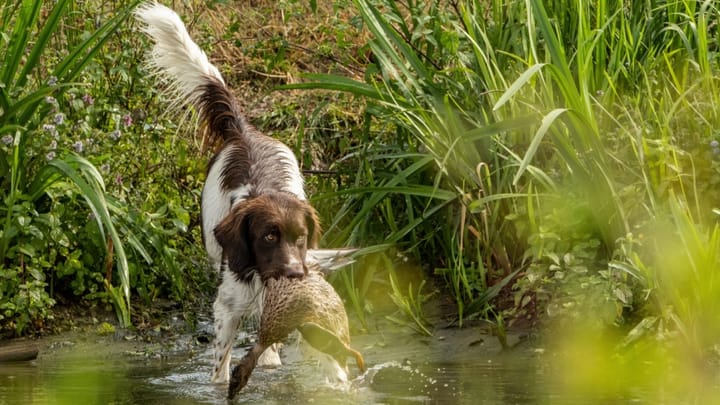Drentsche Partridge Dog
Other names : Drentse Patrijshond, Drent, Dutch Partridge Dog


The Dutch Partridge Dog is a versatile hunting breed. It bears a close resemblance to the spaniel and English setter breeds. Happiest when they're working or exercising, these dogs are best suited to the rural lifestyle and may struggle to adapt to urban environments. The Dutch Partridge Dog has a loyal and sweet-natured disposition. They form exceptionally strong bonds with their owners and are really good around small children.
|
Life expectancy |
The Drentsche Partridge Dog has a life expectancy of between 12 and 14 years |
|
Temperament |
|
|
Size |
Medium
|
|
Adult size |
Female
Between 22 and 24 in
Male
Between 23 and 25 in
|
|
Adult weight |
Female
Between 55 and 68 lb
Male
Between 66 and 77 lb
|
|
Coat colour
Brown and white, tri-colour, with or without flecks or spots. |
White Brown |
|
Type of coat
Short, dense, waterproof coat. Feathery around the tail, ears, and legs. |
Long |
|
Eye colour
Dark brown, amber. |
Brown
|
This dog needs lots of high-energy exercise. This need can’t be overstated. Without enough physical stimulation, a Partridge Dog will become a very unhappy dog.
She is still very much a working dog in her native Netherlands. So think carefully before adopting one. The Drentse Patrijshond is nowhere near as domesticated as some other breeds.
One of the peculiarities of this breed lies in the fact that, during the search, her tail is agitated by a rotary movement, more and more rapidly as she approaches her prey.
More details about the Drentsche Partridge Dog
Drentsche Partridge Dog: Origins and history
The Partridge dog was developed in the Drenthe region of the Netherlands during the sixteenth century. Although she was primarily used as a hunting and retrieving dog, she often did extra work as a guard dog.
The Drentse Patrijshond is also much stronger than she looks and many farmers and merchants used this breed to pull carts loaded with goods.
Today, there are an estimated 5,000 Partridge Dogs registered in the Netherlands. It remains relatively unknown throughout the rest of the world and wasn't recognised by American Kennel clubs until 2010.
Physical characteristics of the Drentsche Partridge Dog
This is a well-proportioned dog with a strong, muscular frame that allows her to reach the speed necessary for a hunting dog. She has a dense white coat with large brown markings, and a deep chest with a long, well-developed rib cage. She has a wedge-shaped head, short muzzle and long, hanging ears, and her wide-set eyes give her an intelligent expression. These dogs can easily be mistaken for a Springer Spaniel or English Setter.
FCI classification of the Drentsche Partridge Dog
-
Group 7 - Pointing Dogs
-
Section 1 : Continental Pointing Dogs
Drentsche Partridge Dog: Characteristics
Drentsche Partridge Dog: Behaviour
Training a Drentsche Partridge Dog
This smart dog is a real pleasure to train. The vast majority of owners have no problems handling these naturally obedient dogs.
Drentsche Partridge Dog: Lifestyle
Breed compatibility Drentsche Partridge Dog
Drentsche Partridge Dog: Purchase price
We do not have enough data to set an average price. Looking after a dog of this size typically costs between £70 to £100 a month, including food, medical/insurance, and incidental expenses.
Drentsche Partridge Dog: Grooming
Despite having a thick coat, the Dutch Partridge Dog doesn’t require much grooming. A weekly brush will keep her fur clean and healthy.
Drentsche Partridge Dog: Health
This is a very healthy dog, with an average life expectancy of 13 years.
This is a tough, robust animal that was bred to thrive in rugged environments. She’s well-balanced, muscular, and durable.
This dog sheds heavily in preparation for the warmer months of the year. She has no problems getting through the average British summer, but should be steered towards water in heat waves.
Her dense coat keep the Drentse Patrijshond warm during the winter.
As she gets older, a Partridge dog becomes noticeably less active. This can lead to unwanted weight gain unless you reduce her food intake.
- Ear infections
- Hip Dysplasia
- Entropion
- Hunting injuries
Do you want a Drentsche Partridge Dog dog ?
Oh no...
There are no Drentsche Partridge Dog adoption profiles at the moment...






